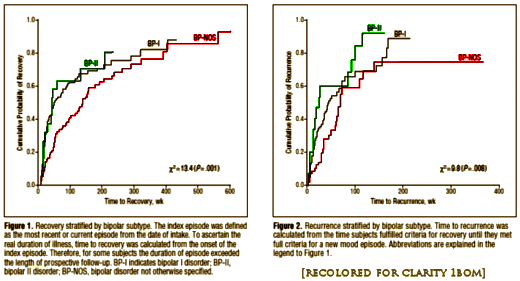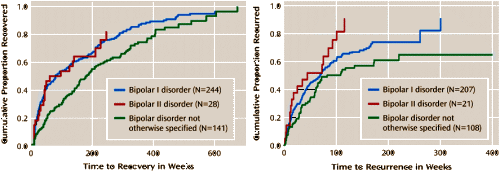The DSM-III [1980] fractionated what had been called Manic Depressive Illness into two disorders – Major Depression, Recurrent and Bipolar Disorder[s] – based on the presence of a Manic Episode. It had a category – Atypical Bipolar Dsorder – for cases that did not meet their full criteria for Mania. In the DSM-IIIR [1988], they added that group as Bipolar Disorder NOS [and mentioned that it was being called "Bipolar II"]. By the coming of the DSM-IV [1994], that group had become Bipolar II. Now, in the COBY Study, Bipolar NOS is defined as another member of the family:
Children and adolescents aged 7 to 17 years 11 months (mean±SD age, 13.0±3.1 years) whose primary diagnoses were DSM-IV BP-I or BP-II or an operationalized definition of BP-NOS were enrolled in the COBY study. Because the DSM-IV definition of BP-NOS is vague, BP-NOS was defined as the presence of clinically relevant BP symptoms that did not fulfill the DSM-IV criteria for BP-I or BP-II. In addition, subjects were required to have a minimum of elated mood plus 2 associated DSM-IV symptoms or irritable mood plus 3 DSM-IV associated symptoms, along with a change in the level of functioning, duration of a minimum of 4 hours within a 24-hour period, and at least 4 cumulative lifetime days meeting the criteria.
And notice that the Polarity of the Index Episode in those cases is also Not otherwise specified:
Furthermore, in their new Bipolar NOS, between 30 and 40% of the cases don’t even have a periodic illness:
So if Bipolar II is Bipolar Lite, then I guess that their version of Bipolar NOS is Bipolar UltraLite. I’m being facetious because I feel like I’m being played in this Study. It hides too much. I’d like to see a symptom breakdown, for example. The DSM isn’t solid enough to accept without some proof. Evidence-based medicine calls for evidence. And their comments about "subsyndromal" symptoms or:
… a minimum of elated mood plus 2 associated DSM-IV symptoms or irritable mood plus 3 DSM-IV associated symptoms, along with a change in the level of functioning, duration of a minimum of 4 hours within a 24-hour period, and at least 4 cumulative lifetime days meeting the criteria.
feels contrived. So, I think they’re stretching the diagnosis of Bipolar Disorder to fit their preconceived notions. I admit to being a "preconceived" skeptic myself. For thirty years, I’ve been looking for the promised cohort of mis-diagnosed Bipolar adults, and they haven’t materialized. And since I’ve been working in the general clinics after my retirement, I’ve had to learn not to wince when people say, "I’ve been diagnosed Bipolar" or "Do you think I might be Bipolar?" There are some, sure enough, but the majority are people with longstanding characterologic problems of various sorts who take Bipolar medicines [which have not altered the course of their lives, by their own admission]. So I’m staying Kraepelinian, at least with adults.
On the other hand, I accept that the COBY Study has a respectable number of Bipolar I kids that seem to have all the right stuff for the diagnosis – duration of episode, appropriate periodicity, syndrome specific symptoms, family history. So, my take from this study is that I’m not a bipolar-kids-deny-er, just someone who thinks they’re pushing the diagnosis way further than they ought to. It makes perfect sense that the disorder would start in childhood, but I’d still like to see cases from childhood that went on to develop "classic" Manic Depressive adulthoods [and I’d still like to see a case in the flesh!].
I’m particularly interested in the child and adolescent diagnostic category because I see them now [there’s not anyone else to see them here in the woods]. I may not know all I need to know to see them, but I’m way ahead of the alternatives. And I see lots of kids on Atypicals or some kind of Mood Stabilizers for questionable reasons, even by COBY standards. So I have first-hand knowledge that kids are being over-medicated or badly medicated. I have yet to see a child that fits these criteria, but I’ll keep looking. There are a couple of adolescents I’d give a maybe – usually with a very Bipolar parent.



Santioned!
http://www.bizjournals.com/boston/news/2011/07/01/mass-general-punishes-three.html
Biederman, Wilens, Spencer the Child Bipolar gang is busted for breaking hosp ethics and taking pharm money and not reporting, ala the Grassley investigation
YAY!!
They must refrain from “all industry-sponsored outside activities” for one year.
• For two years after the ban ends, they must obtain permission from Mass. General and Harvard Medical School before engaging in any industry-sponsored, paid outside activities and then must report back afterward.
• They must undergo certain training.
• They face delays before being considered for “promotion or advancement.”
“It makes perfect sense that the disorder would start in childhood, but I’d still like to see cases from childhood that went on to develop “classic” Manic Depressive adulthoods [and I’d still like to see a case in the flesh!].”
What I’m reading is that juvenile-onset Bipolar may not develop into the “classic” Manic Depression seen in adult-onset cases — it may be a different kettle of fish in the way that bipolar with mixed episodes or rapid-cycling is different.
I’m also reading that the “classic” form is not the prevalent form in adulthood, either. This helps to explain why Lithium only works for certain people, predominantly the types who have the MDI pattern of manic-depression.
To me, the goals in getting prompt treatment for a child/adolescent with Bipolar would be to ward off the possible development of BP1 with full mania, and to slow the cycling. Stopping the cycle would be better but we’re not there yet.